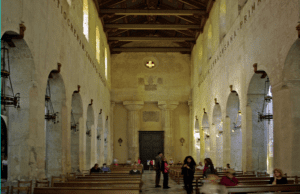This is an amazing site and so completely different to anywhere else I have visited. It was truly on of the highlights of a trip to Sicily.
The Greeks settled Sicily from the C7th and built temples to their gods and godesses. Christianity arrived early in Sicily, which was supposedly visited by both St Peter and St Paul on their way to Rome. The Greek and Roman temples were either destroyed or became early Christian churches. Ortygia Cathedral is unique as it is still possible to see the remains of the original Greek Temple which gives it a completely different to any other religious building.
In the C5th BC, the Greek temple to Athena dominated the Acropolis on the highest point of the island of Ortygia. It was a typical Greek temple with six columns on the short sides and fourteen on the long sides. It became a church when the island was evangelised by St Paul. The present cathedral was constructed in the C7th by Saint Bishop Zosimo of Syracuse. The Doric columns became part of the outer walls. These, along with the three stepped platform they were built on, and can be seen along Via Minerva. Internally, arches were carved through walls of cella to form nave.
The church became a Byzantine cathedral in 640AD. During the Arab settlement, it was converted into a mosque. When Sicily fell to the Normans, they appointed Latin bishops and the building became (and still is) a Roman Catholic Cathedral. The original roof was removed and the walls were extended upwards and crenellated. A typical Norman apse was added at the east end.
The west front was damaged in the 1693 earthquake and was replaced by the splendid Baroque facade with the statue of the Virgin Mary above the west door. On pinnacles on either side are St Lucia, the patron saint of Siracusa and a C5th bishop, St Marciano.
Inside, the cathedral is unique and has a very different feel to any other Christian churches and cathedrals. It still has the feel of a Greek temple. The only natural light comes through windows high in the walls adding to the intimate feel. The original Doric columns can still be seen along the outer walls of the side aisles and on either side of the west door.
At the end of the north aisle is a simple Norman apse with a blocked Norman window containing a small stone altar with a statue of the Madonna of the Snow.
It is very different to the main apse at the east end with its white plaster walls, Baroque altar and reredos with a painting of the Nativity of the Virgin, which feels out of place compared to the rest of the building.
A passage to the right of the main altar leads to the Chapel of the Crucifix, with its C13th crucifix and painted dome. This is very dark with little natural light. On the side walls are massive altars containing reliquary boxes with bones of saints.
There are Baroque chapels off south aisle, set behind decorative metal grille doors. The Chapel of the Blessed Sacrament is reserved for private prayer and has C17th frescoes on the ceiling and a massive Baroque altar with gilded pillars and a painted ceiling with C17th frescoes.
Next to it is the Chapel of St Lucia, the patron saint of Orygia. The altar holds a silver reliquary box with bone fragments from the saint. Above is a portrait of St Lucia. A C16th silver statue of the saint in a locked glass fronted niche is paraded round the streets on December 13th, her festival day.
There is a small charge to enter the cathedral but it is well worth visiting. It is a unique and very atmospheric place.










